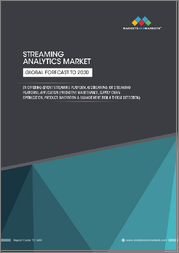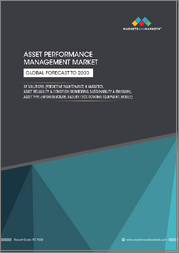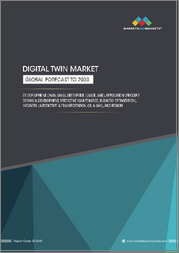
|
시장보고서
상품코드
1643865
세계의 상용차(CV) 예지보전 산업(북미, 유럽, 인도, 2024-2029년)Commercial Vehicle (CV) Predictive Maintenance Industry, North America, Europe, and India, 2024-2029 |
||||||
운영 효율성 향상과 유지보수 비용 절감으로 성장을 견인하는 예후 예측
상용차 산업은 급속한 기술 발전과 효율성, 안전성, 지속가능성에 대한 수요 증가에 힘입어 큰 변화의 시기를 맞이하고 있습니다. 이러한 변화에서 가장 혁신적인 것은 실시간 데이터를 기반으로 차량의 상태와 성능을 예측하는 예후 예측 능력입니다. 본 조사에서는 상용차 예후예측, 생태계, 주요 참여업체, 시장 점유율에 대해 심층적으로 조사하였습니다. 또한 주요 동향과 사례연구를 통해 예후예측이 정비 방식에 혁명을 일으키고, 운영 효율성을 높이고, 비용을 절감할 수 있는 잠재력을 강조합니다. 이번 조사는 북미, 유럽, 인도의 3.5톤 이상 상용차에 초점을 맞췄습니다. 선진국과 신흥국 시장을 모두 포함시킴으로써 이들 지역의 기회와 과제를 종합적으로 파악할 수 있습니다.
상용차 예후 예측은 데이터 분석, 인공지능(AI), 머신러닝(ML) 알고리즘을 활용하여 차량 부품의 고장 및 유지보수 필요성을 사전에 예측합니다. 이 연구는 먼저 예후 예측을 정의하고, 일반적으로 사용되는 몇 가지 ML 접근법을 소개하며, 상용차 용도에 대한 예후 예측의 범위를 5년간의 타임라인을 통해 설명하고, 이러한 예측적 접근법과 기존의 사후 대응 및 예방적 유지보수 관행과의 날카로운 대비를 강조합니다.
상용차 예후 예측의 성장 기회는 기존의 유지보수 전략이 비효율적이고 과도한 다운타임을 초래하는 경우가 많기 때문에 유지보수 및 운영 비용을 크게 절감할 수 있는 잠재력을 가지고 있습니다. 상용차가 고도화됨에 따라 차량 데이터의 가용성은 최고조에 달하고 있습니다. 이 데이터는 진단 도구와 텔레매틱스라는 두 가지 주요 경로를 통해 차량에서 추출되며, 예후 예측을 위한 ML 알고리즘에 공급되는 소스가 됩니다. 이러한 데이터 소스를 살펴본 후, 본 조사에서는 이러한 데이터 채널을 활용하여 예지보전 서비스를 제공하는 예지보전 생태계의 다양한 참여자들을 분류하였습니다. 또한, 이들 참여자 간의 상호 관계와 그 기능에 대해 논의하고, 새로운 스타트업 기업, 신흥 리더 기업, 지배적 기업을 식별하고, 주요 기업 간의 매핑을 통해 의미 있는 통찰력을 도출하여 현장의 시나리오에 빛을 던져주고 있습니다.
예후 예측 시스템은 텔레매틱스 및 자율주행과 같은 다른 신기술과 통합되어 잠재적인 이점을 증폭시킬 수 있습니다. 이 보고서는 이러한 혁신을 고려하여, 업계에 영향을 미칠 수 있는 주요 트렌드를 매핑하고, 2024년의 세 가지 주요 트렌드(디지털 트윈, OTA 업데이트, ML의 발전)를 사례 연구와 함께 자세히 설명합니다.
상용차 예후예측의 유망성에도 불구하고, 예후예측의 상용차 보급은 몇 가지 과제에 직면해 있습니다. 예후 예측의 주요 성장 저해요인인 범퍼 투 범퍼(bumper to bumper) 솔루션의 높은 오감지율로 인해 차량 소유주 및 OEM은 광범위한 채택을 꺼리고 있습니다. 오감지로 인해 예후 예측은 틈새 시장으로 제한되어 있으며, AI 및 ML 분야에서는 분석 및 데이터 과학 기업들이 이러한 오감지를 줄일 수 있는 정확한 알고리즘을 개발하여 보다 광범위한 사용자층에 솔루션을 보급할 수 있습니다.
결론적으로 본 조사에서는 북미, 유럽, 인도의 상용차 시장에서 2023년 기준 시장 규모, 설치 기반, 보급률 및 예후 예측을 추정하고 있습니다. 또한, 조사 대상 지역 전체의 수익과 시장 추정 및 예측에 대해 2029년까지 5년간의 예측을 제시합니다.
예후 예측은 상용차 업계에 큰 이점을 가져다주는 혁신의 기회가 될 수 있습니다. 기술이 발전함에 따라 예후 예측 시스템의 채택은 점점 더 확산될 것으로 보입니다. 예후 예측은 예후 예측 전문 기업, 텔레매틱 서비스 제공업체, OEM 간의 전략적 파트너십과 M&A를 통해 유지보수 생태계를 재구성하고, 차량 관리의 다음 혁신의 물결을 주도하고 있습니다.
목차
상용차(CV) 예지보전 변혁
- 왜 성장이 어려워지고 있는가?
- The Strategic Imperative 8(TM)
- CV 메인터넌스 업계 3 대전략 임팩트
목적, 목표, 범위
- 조사 목적
- 조사 방법
- 조사 범위
성장 환경
- 경쟁 환경
- 주요 조사 결과
- 성장 촉진요인
- 성장 억제요인
- 예후 예측 정의
- 예후 예측 모델 도입 접근
- CV 예후 예측 범위
CV 메인터넌스 예후 예측 솔루션
- CV 메인터넌스 예후 예측 데이터 채널
- CV 메인터넌스 예후 예측
- CV 예후 예측·솔루션 제공 채널
- 텔레매틱스 데이터에 의한 CV 메인터넌스의 예후 예측
- CV 메인터넌스의 예후 예측 응용
상용차 예후 예측 에코시스템
- 예후 예측 서비스에 의한 플릿 오너 부가가치 향상
- 밸류체인 예후 예측
- 세계 : 예후 예측 OEM - 이용 가능한 솔루션
- 세계 : 예후 예측과 진단 툴 전업 기업
- 주요 에코시스템 참가 기업 비교(2023년)
동향으로 사례 연구
- 예후 예측 주요 동향
- 동향 : 디지털 트윈과 센서 퓨전
- 사례 연구 : Intangles - 디지털 트윈 기업
- 동향 : OTA 업데이트
- 사례 연구 : Volvo Trucks Uptime Center - OTA 업데이트
- 동향 : CV 메인터넌스 딥러닝과 AI
- 사례 연구 : CerebrumX
지역 분석
- 지역 분석 : 북미
- 지역 분석 : 유럽
- 지역별 분석 : 인도
- 예후 예측 솔루션 제공업체의 점유율
- 매출 분석
성장요인
- 성장 지표
- 매출 예측 인사이트
- 매출 예측 : 지역별
- 대수 예측 : 지역별
- 매출 예측 시나리오 분석
- 설치 기반 예측
- 가격 동향과 예측 분석
- 주요 성장 촉진요인 : TSP와 예후 예측 기업 파트너십
- 주요 성장 억제요인 : 오류 검출이 많기 때문에 도입이 더디다.
베스트 프랙티스 평가
- 베스트 프랙티스 평가 : Pitstop
- 베스트 프랙티스 평가 : Intangles
- 베스트 프랙티스 평가 : CerebrumX
성장 기회
- 성장 기회 1 : 예후 예측 서비스(PaaS)
- 성장 기회 2 : 재고 자동화
- 성장 기회 3 : 머신러닝과 AI 개발
다음 단계
- 성장 기회 이점과 임팩트
- 다음 단계
- 별지 리스트
- 면책사항
Prognostics is Driving Growth by Increasing Operational Efficiency and Reducing Maintenance Costs
The commercial vehicle industry is undergoing a major transformation, fueled by rapid technological advancements and rising demand for efficiency, safety, and sustainability. A standout innovation in this shift is prognostics, which is the ability to predict vehicle health and performance based on real-time data. This study takes a deep dive into prognostics in commercial vehicles, the ecosystem, key participants, and their market share. It also identifies key trends and case studies and highlights the potential of prognostics to revolutionize maintenance practices, enhance operational efficiency, and drive cost savings. The focus of this study is on commercial vehicles that weigh more than 3.5 tons in North America, Europe, and India. By including both developed and developing markets, the study provides a comprehensive view of the opportunities and challenges in these regions.
Prognostics in commercial vehicles leverages data analytics, artificial intelligence (AI), and machine learning (ML) algorithms to forecast vehicle component failures and maintenance needs before they occur. The study kicks off by defining prognostics, listing some common ML approaches used, outlining the scope of prognostics regarding commercial vehicle applications with a 5-year timeline, and highlighting the sharp contrast of this predictive approach with traditional reactive and preventive maintenance practices.
The growth opportunity in prognostics for commercial vehicles lies in its potential to significantly reduce maintenance and operational costs, as traditional maintenance strategies often lead to inefficiencies and excessive downtime. As commercial vehicles become more sophisticated, vehicle data availability is at its peak. This data is extracted from the vehicle through 2 primary routes-diagnostics tools and telematics, which become the sources to feed prognostics' ML algorithms. After touching upon these data sources, the study moves on to classify different categoric participants of the predictive maintenance ecosystem that leverage these data channels to offer prognostics services. The study also discusses the inter-relationships between these participants and their functions, identifies new start-ups, emerging leaders, and dominant companies, and throws light on the on-ground scenario by drawing meaningful insights by mapping key companies against each other.
The integration of prognostics systems with other emerging technologies, such as telematics and autonomous driving, amplifies its potential benefits. Considering these innovations, this study maps key trends with their impact on the industry against certainty and discusses the top 3 trends of 2024 (digital twins, OTA updates, and advances in ML, each of which is elaborated along with a case study).
Despite its promise, the widespread adoption of prognostics in commercial vehicles faces several challenges. A key growth restraint in prognostics-high false positives in bumper-to-bumper solutions, which has kept fleet owners and OEMs from widespread adoption-is discussed. False positives have restricted prognostics to a niche and made it an application-specific market. Here lies another notable opportunity in the AI and ML domains for analytics and data science companies to develop accurate algorithms that can reduce these false positives, increasing the solution's adoption across a wider user base.
In conclusion, the study estimates market size, installed base, and penetration of prognostics as of 2023, across the North American, European, and Indian commercial vehicle markets. In addition, it offers a 5-year forecast until 2029 for revenues and estimated market bases across the regions of study.
Prognostics represents a transformative opportunity for the commercial vehicle industry, offering significant advantages. As technology evolves, the adoption of prognostics systems will become increasingly prevalent. Prognostics is reshaping the maintenance ecosystem through strategic partnerships and mergers and acquisitions among dedicated prognostics companies, telematic service providers, and OEMs, driving the next wave of innovation in fleet management.
Table of Contents
Transformation in CV Predictive Maintenance
- Why Is It Increasingly Difficult to Grow?
- The Strategic Imperative 8™
- The Impact of the Top 3 Strategic Imperatives on the CV Maintenance Industry
Aims, Objectives, and Scope
- Aims and Objectives
- Research Methodology
- Scope
Growth Environment
- Competitive Environment
- Key Findings
- Growth Drivers
- Growth Restraints
- Definition of Prognostics
- Approaches to Implementing Prognostics Models
- Scope of Prognostics in CVs
Prognostics Solutions in CV Maintenance
- Data Channels for Prognostics in CV Maintenance
- Prognostics in CV Maintenance
- Channels to Offer Prognostics Solutions in CVs
- Prognostics in CV Maintenance through Telematics Data
- Applications of Prognostics in CV Maintenance
Prognostics Ecosystem in Commercial Vehicles
- Value Addition for Fleet Owners through Prognostics Services
- Prognostics in the Value Chain
- Global*: OEMs in Prognostics-Available Solutions
- Global: Dedicated Prognostics and Diagnostics Tool Companies
- Comparison of Key Ecosystem Participants, 2023
Trends and Case Studies
- Key Trends in Prognostics
- Trend: Digital Twin and Sensor Fusion
- Case Study: Intangles-A Digital Twin Company
- Trend: OTA Updates
- Case Study: Volvo Trucks Uptime Center-OTA Updates
- Trend: Deep Learning and AI in CV Maintenance
- Case Study: CerebrumX
Regional Analysis
- Regional Analysis: North America
- Regional Analysis: Europe
- Regional Analysis: India
- Prognostics Solution Providers' Share
- Revenue Share Analysis
Growth Generator
- Growth Metrics
- Revenue Forecast Considerations
- Revenue Forecast by Region
- Units Forecast by Region
- Revenue Forecast Scenario Analysis
- Installed Base Forecast
- Pricing Trends and Forecast Analysis
- Key Growth Driver: Partnerships between TSPs and Prognostics Companies
- Key Growth Restraint: Slower Adoption Because of High False Positives
Best Practices Recognition
- Best Practices Recognition: Pitstop
- Best Practices Recognition: Intangles
- Best Practices Recognition: CerebrumX
Growth Opportunity Universe
- Growth Opportunity 1: Prognostics-as-a-service (PaaS)
- Growth Opportunity 2: Inventory Automation
- Growth Opportunity 3: Developments in Machine Learning and AI
Next Steps
- Benefits and Impacts of Growth Opportunities
- Next Steps
- List of Exhibits
- Legal Disclaimer



















